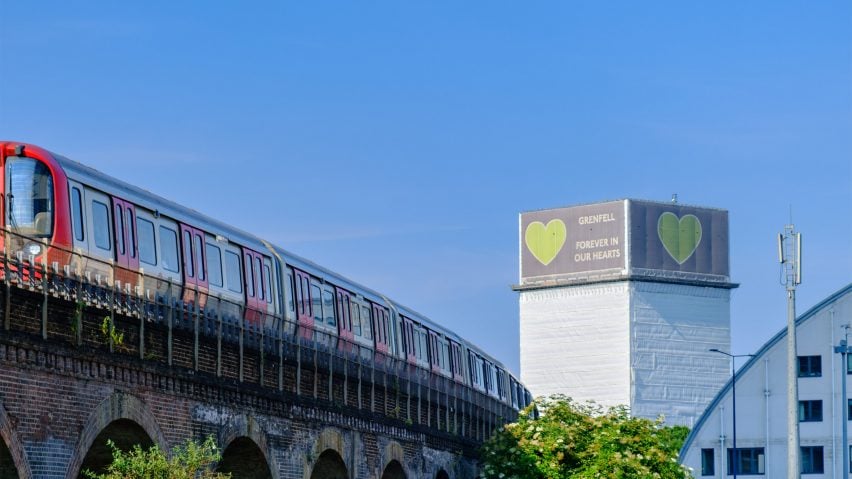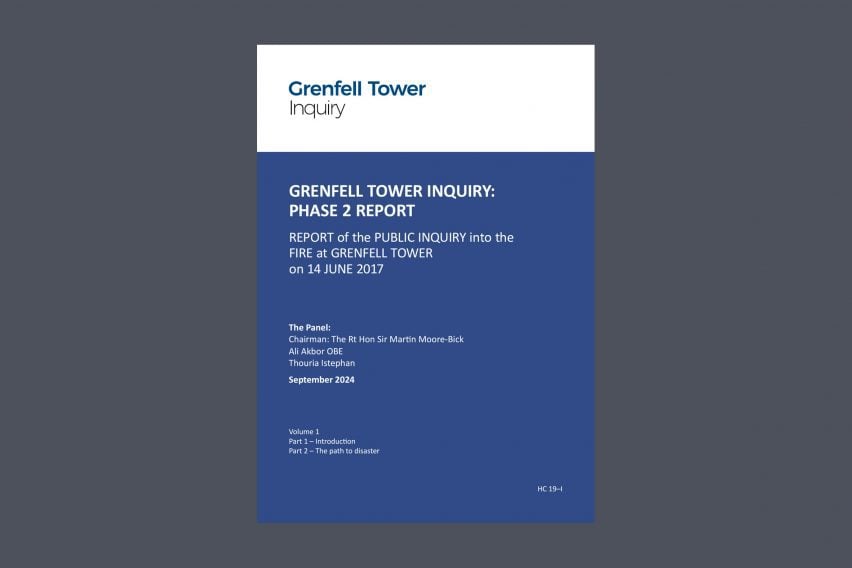
Grenfell Tower Inquiry concludes that architect "bears a very significant degree of responsibility"
The architecture studio that refurbished Grenfell Tower has been excoriated in the final report of the long-running public inquiry into a devastating fire at the building in 2017.
London-based Studio E was determined to have "demonstrated a cavalier attitude to the regulations affecting fire safety" during its work on the project, which included the installation of highly flammable cladding to the block's exterior.
Published today, the 1,700-page report found that Studio E, which has since gone into liquidation, "bears a very significant degree of responsibility for the disaster".
Studio E "fell below standard of a reasonably competent architect"
"As architect Studio E was responsible for the design of the external wall and for the choice of the materials used in its construction," the report said.
The studio had specified zinc cladding for the project, which was later swapped for a deadly aluminium composite material (ACM) product by the client, Kensington and Chelsea Tenant Management Organisation (TMO), in a bid to reduce costs.
But the inquiry concluded that it was still the architect's responsibility to check that the ACM complied with building regulations.
"Its failure to recognise that ACM was dangerous and to warn the TMO against its use represented a failure to act in accordance with the standard of a reasonably competent architect," the report said.
During the course of the inquiry, Studio E contended that its role on the project was to guide aesthetics, and that responsibility for fire safety and compliance lay with other parties.
Studio E, as well as the project contractor, Rydon, and the cladding sub-contractor, Harley, were criticised for taking "a casual approach to contractual relations".
"They did not properly understand the nature and scope of the obligations they had undertaken, or, if they did, paid scant attention to them," the report said.
"They failed to identify their own responsibilities for important aspects of the design and in each case assumed that someone else was responsible for matters affecting fire safety."
Studio E was also at fault for failing to recognise that the combustible Celotex foam insulation fitted as part of the project was unsuitable, the inquiry found.
It also failed to ensure that fire-safety consultant Exova completed a fire-safety strategy for the refurbished building, failed to understand that it was responsible for work by sub-contractors and missed errors around the windows that helped the fire to spread.
"The deaths that occurred were all avoidable"
Seventy-two people were killed after a fire broke out at Grenfell Tower, a 1970s North Kensington social-housing block, in the early hours of 14 June 2017.
Started by a faulty fridge-freezer, the fire spread rapidly up and around the building via the external cladding system installed as part of the refurbishment project, which was completed only a year earlier.
Today's report marks the end of a seven-year-long public inquiry into the disaster, which was the deadliest residential fire in the UK since world war two.
"The simple truth is that the deaths that occurred were all avoidable, and those who lived in the tower were badly failed over a number of years and in a number of different ways by those who were responsible for ensuring the safety of the building and its occupants," inquiry chair Martin Moore-Bick said in a statement this morning.

"All contributed to it in one way or another, in most cases through incompetence, but in some cases through dishonesty and greed," he added.
In particular, manufacturers of the cladding and insulation products – Arconic Architectural Products, Celotex and Kingspan – were concluded to have engaged in "systemic dishonesty".
"They engaged in deliberate and sustained strategies to manipulate the testing processes, misrepresent test data and mislead the market," the report said.
Meanwhile, the UK Government was "well aware" of the danger posed by combustible cladding and insulation, but "failed to act on what it knew".
Criminal charges not expected until end of 2026
Phase two of the enquiry aimed to identify the causes of the disaster, with more than 80 weeks of evidence heard.
A phase one report focusing on the events on the night of the fire published in 2019 already concluded that Grenfell Tower's external walls did not comply with building regulations.
Though the inquiry is barred from drawing conclusions about criminal responsibility, its findings are likely to have a bearing on the ongoing police investigation into the fire. Detectives are not expected to pass charging files to prosecutors until late 2026.
Lawyers representing Studio E confirmed to Dezeen that it would not be commenting on the inquiry report.
In a closing statement to the inquiry, the studio had argued that the large number of high-rise buildings found to have similar cladding to Grenfell after the fire "demonstrates that Studio E acted in a manner consistent with a responsible body of its profession".
But the inquiry report turned this claim on its head, suggesting that this could be point to "a widespread failure" across the architecture profession.
"The evidence, not least the fact that similar materials have since been found on hundreds of other high-rise buildings, suggests that there may be a widespread failure among the profession to investigate properly or understand the nature of the materials being chosen for that purpose," it said.
While recognising steps taken by the Architects Registration Board and the Royal Institute of British Architects to improve knowledge among architects since the fire, the inquiry recommended that these changes be reviewed to ensure they are sufficient in light of its findings.
It also recommended that architects be legally required to issue a statement declaring that "all reasonable steps have been taken" to ensure projects comply with building regulations as part of applications for building-control approval on higher-risk projects.
In April 2023, a group of more than 900 people affected by the fire agreed a settlement with companies and public bodies involved in the refurbishment, including Studio E, for an undisclosed sum of compensation.
In July, the Grenfell Tower Memorial Commission and the Royal Institute of British Architects launched the process to select the design team for a memorial on the site of Grenfell Tower, which is still standing.
The design brief specifies that the memorial should be in the form of a garden and display the names of the 72 people who perished in the fire. A shortlist of five studios will be selected in the autumn.
The main photo is by Iordanis via Shutterstock.